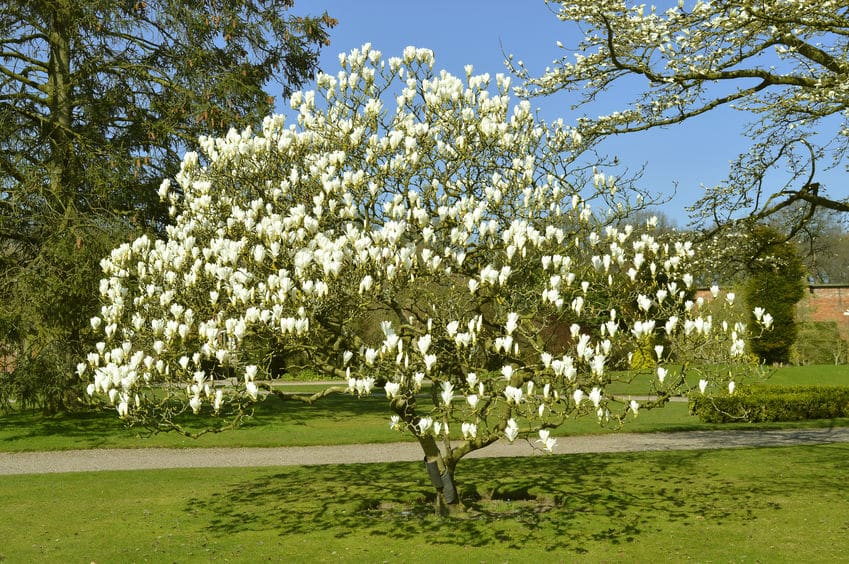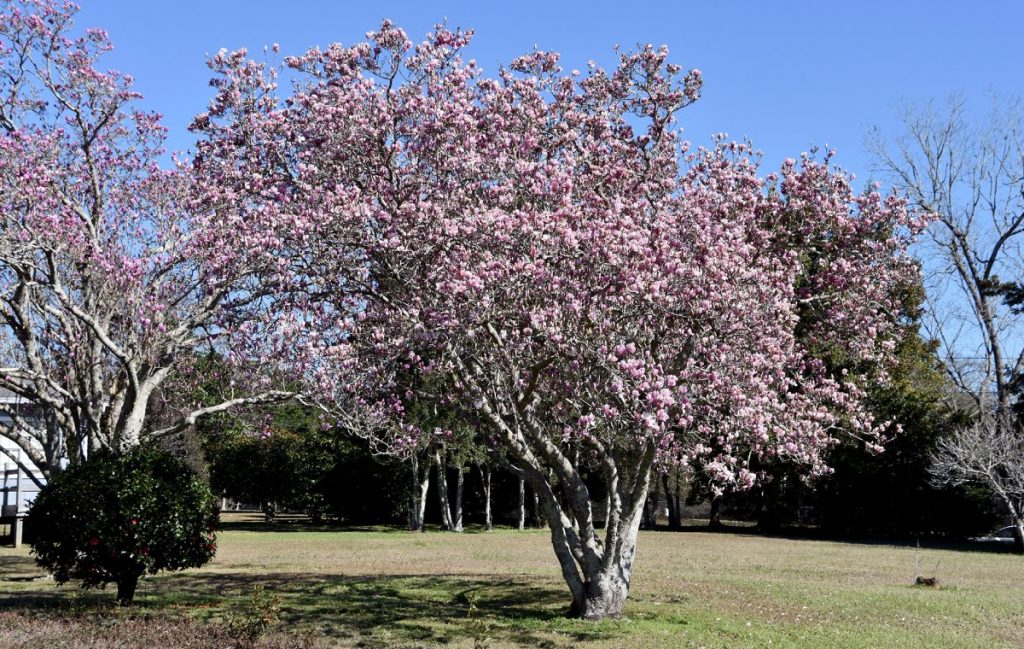Welcome to the world of magnolia trees, a beautiful addition to any landscape and the key to creating an amazing outdoor oasis. magnoliatreeremoval.com welcomes you to go on a voyage of exploration and care for these beautiful trees with our detailed guide. As arboricultural experts, we are excited to offer our knowledge on how to care for a magnolia tree so that it can thrive in all of its magnificence. Magnolias, with their magnificent flowers and timeless charm, require special care. Whether you’re a seasoned gardener or a newbie enthusiast, this guide will walk you through the complexities of magnolia tree care, from selecting the best location to dealing with seasonal subtleties. Let’s discover the secrets of caring for these floral masterpieces, which will give elegance and natural beauty to your surroundings.
How to care for a magnolia tree?
1. Understanding Magnolia Varieties
Dive into the enthralling world of magnolia variants, which come in a wide range of forms, sizes, and colours. Magnolia contains a diverse range of species and hybrids, each with its own distinct traits. From the classic Southern Magnolia (Magnolia grandiflora) with its glossy evergreen foliage and huge, fragrant flowers to the delicate blooms of the Star Magnolia (Magnolia stellata), the options are as many as they are enticing. Some magnolias bloom in early spring, while others bloom in late spring or early summer, offering a lengthy display in your garden. Understanding the differences between magnolia kinds allows you to select the best one for your environment, whether you want brilliant, spectacular blossoms or a more subtle, traditional look.

Join us as we explore the various world of magnolia trees to choose the one that will become the focal point of your outdoor retreat.
2. Choosing the Right Location
Choosing the correct site is an important step in maintaining the thriving beauty of your magnolia tree. Magnolias have specific demands for sunshine, soil, and space. Aim for a location that receives enough of sunshine, preferably in the morning with some afternoon shade, since this encourages robust development and vivid flowers. Magnolias require well-drained soil and like slightly acidic to neutral pH levels. Adequate spacing is essential for the tree to extend its branches elegantly without crowding or competition from other plants. Consider the mature size of the magnolia variety you’ve picked, as well as its potential canopy and root spread. Strategic positioning not only improves the tree’s visual impact but also benefits its general health.
3. Planting Your Magnolia Tree
Planting a magnolia tree is a joyful and simple process that sets the groundwork for a lifetime of graceful development and flowering beauty. Begin by excavating a hole twice as broad but only as deep as the root ball. Loosen the soil at the bottom and treat it with organic matter to improve drainage and nutrient availability.

Remove the magnolia from its container gently, making sure the roots are not around the root ball. Place the tree in the centre of the hole, adjusting the depth so that the surface of the root ball is even with the surrounding dirt. Backfill the hole with the modified dirt and thoroughly water to settle the roots. Mulch around the tree’s base to keep moisture in and weeds at bay. Watering regularly throughout the first year is essential for establishment. Your magnolia will start on a voyage of development with proper planting care, adorning your environment with its own appeal.
4. Watering Wisdom
Watering your magnolia tree correctly is critical to its health and viability. Magnolias like dependably wet soil, particularly in their early development years. As a general rule, 1 to 1.5 inches of water per week should be provided, either by rainfall or irrigation. Deep watering is necessary to allow liquid to permeate the soil and reach the complete root system. Concentrate on the drip line of the tree, which extends from the tree’s outermost branches. Watering first thing in the morning permits the leaves to dry over the day, lowering the danger of illness. Regularly check the soil moisture and adapt your watering plan depending on the weather. Overwatering should be avoided since magnolias are sensitive to root rot in wet soil. You help the environment by learning the art of watering.
5. Fertilization Techniques
Fertilizing your magnolia tree is an important part of promoting its development and general health. Choose a balanced, slow-release fertilizer designed exclusively for woody plants. Apply the fertilizer in early spring, before new growth begins, to help the magnolia receive important nutrients during its active growing season. Spread the fertilizer evenly across the drip line of the tree, avoiding direct contact with the trunk. Over-fertilization might be harmful to the tree. Water the area well after treatment to aid nutrient uptake. Consider taking a soil test to understand the exact demands of your magnolia and modifying the fertilizer type and amount accordingly. Regular fertilization encourages robust foliage, bright flowers, and a blooming magnolia that becomes a focal point in your garden.
6. Pruning Practices
Pruning your magnolia tree is essential for ensuring its structural integrity, aesthetic appeal, and overall health. Begin by removing dead or broken branches, which promotes air circulation and reduces disease risk. Shape the tree to improve its natural shape, paying special attention to any undesired crossing branches. To reduce stress on the tree, prune during the dormant season, which is usually late winter or early spring. To promote optimal healing, use clean, sharp equipment and accurate cuts. Thin out dense spots to allow sunlight to penetrate and maintain a balanced canopy. Avoid severe trimming, since magnolias prefer a more natural shape. Regular, intelligent pruning not only improves the tree’s look but also promotes healthy development and lifespan. Pruning your magnolia is beneficial.
Dealing with Pests and Diseases
Protecting your magnolia tree against pests and diseases is critical for its long-term health and vibrancy. Scale insects, aphids, and spider mites are common pests of magnolias. Inspect the leaves, stems, and trunk for symptoms of infection regularly. If identified early, you can easily manage these pests with insecticidal soaps or horticultural oils. Magnolias are also subject to fungal diseases like powdery mildew and leaf spot. To minimize these problems, space trees appropriately and avoid overhead watering. Applying fungicides as a preventive step throughout the growth season can also be useful. Clean away fallen leaves and debris at the base of the tree regularly to reduce possible breeding grounds for pests and diseases. You can keep your magnolia tree robust and blooming in the face of possible hazards by remaining watchful and applying preventative steps.
Related posts:
How to care for a magnolia tree: Seasonal Care Tips
Adapting your care routine to the changing seasons is essential for maintaining a healthy magnolia tree. During spring, focus on promoting new growth by applying a balanced fertilizer. This period is also ideal for pruning, as it allows the tree to shape up before the summer. In the hot summer months, ensure your magnolia receives sufficient water to combat the heat stress. Mulching around the base helps retain soil moisture and regulate temperature. As fall approaches, reduce fertilization to avoid stimulating new growth that may be vulnerable to frost. Continue to water as needed and clear away fallen leaves to prevent potential disease. Winter care involves protecting the tree from harsh conditions. Applying a layer of mulch around the root zone helps insulate the soil, and wrapping the trunk with burlap shields it from cold winds. By tailoring your care routine to each season, you provide optimal conditions for your magnolia tree to thrive year-round. MagnoliaTreeRemoval.com provides a guide to seasonal care tips for magnolia trees.
FAQS
What is the optimum time of year to plant a magnolia tree?
Planting is best done in late winter or early spring when the tree is dormant.
How frequently should I water my magnolia tree?
Water deeply once a week, modifying frequency according to weather and soil moisture.
What is the best fertilizer for magnolia trees?
In early spring, before new growth begins, use a balanced, slow-release fertilizer.
Are there any illnesses that affect magnolia trees?
Magnolias can suffer from scale, fungal infections, and aphids; frequent monitoring can help prevent these problems.
Is it okay to cut my magnolia tree in the summer?
Avoid heavy trimming in the summer; instead, choose for mild care if necessary.
Is it okay to cut my magnolia tree in the summer?
Avoid heavy trimming in the summer; instead, choose mild care if necessary.
How can I protect my magnolia from frost damage in the winter?
Mulch at the base to insulate the roots and protect them from harsh cold.
Conclusion
Finally, knowing how to care for a magnolia tree is the key to guaranteeing its life and vitality. By following the rules indicated for each aspect—from selecting the ideal site to executing proper pruning practices—you contribute to the overall health of your magnolia tree. This thorough care method, adjusted to the unique kinds and environmental circumstances, is critical for a growing magnolia. MagnoliaTreeRemoval.com provides in-depth information and professional guidance on magnolia tree maintenance. Our website is dedicated to offering excellent materials and assistance to assist you in caring and preserving the beauty of your magnolia tree.





